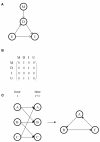Moving toward System Genetics through Multiple Trait Analysis in Genome-Wide Association Studies
- PMID: 22303408
- PMCID: PMC3266611
- DOI: 10.3389/fgene.2012.00001
Moving toward System Genetics through Multiple Trait Analysis in Genome-Wide Association Studies
Abstract
Association studies are a staple of genotype-phenotype mapping studies, whether they are based on single markers, haplotypes, candidate genes, genome-wide genotypes, or whole genome sequences. Although genetic epidemiological studies typically contain data collected on multiple traits which themselves are often correlated, most analyses have been performed on single traits. Here, I review several methods that have been developed to perform multiple trait analysis. These methods range from traditional multivariate models for systems of equations to recently developed graphical approaches based on network theory. The application of network theory to genetics is termed systems genetics and has the potential to address long-standing questions in genetics about complex processes such as coordinate regulation, homeostasis, and pleiotropy.
Keywords: multivariate analysis; pleiotropy; systems genetics.
Figures

References
-
- Butte A. J., Kohane I. S. (2000). Mutual information relevance networks: functional genomic clustering using pairwise entropy measurements. Pac. Symp. Biocomput. 5, 415–426 - PubMed
Grants and funding
LinkOut - more resources
Full Text Sources

